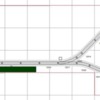I have a few questions:
1-On the FasTack IR and RealTrax ITAD controllers. I’ve given up the idea of a continuous running subway line and instead and considering a point-to-point return loop to a 60-inch station platform on my 3x12 layout. Does either the IR or the ITAD feature the ability to stop a train and then reverse it? I recall 4-5 years ago in either the OGR magazine or the competitor that there was a feature on having bump and go trolleys pause for passengers (instead of slamming into the bumpers and jarring the passengers) and then reverse. My thought is that I would like for the subway loop to be able to run on its own if I choose while I’m doing the switching layout on the upper level.
(Note on rolling stock. I will be using my Lionel M-7’s as “subways” and also bump and go trolleys. Not willing (or able) to spend $600+ on a high tech subway set just to run a short point-to-point.)
2-I would prefer to use RealTrax for this setup, but I know that the anti-derailing function on the turnout requires track power (I’m using the manual turnout on the FasTrack option). Is the train running at low speed as its leaving the station enough power to trip the anti-derailing feature?
(A couple of notes on the track plans. I’m using the FasTrack IR for graphic purposes on the RealTrax layout because I couldn’t locate the ITAD on the RR Track library. Also the subway level is 4-feet wide on the right side as the tracks are running under the control panel area on the upper level. I also know that there are a couple unclosed track connections on the plans I just drafted.)









